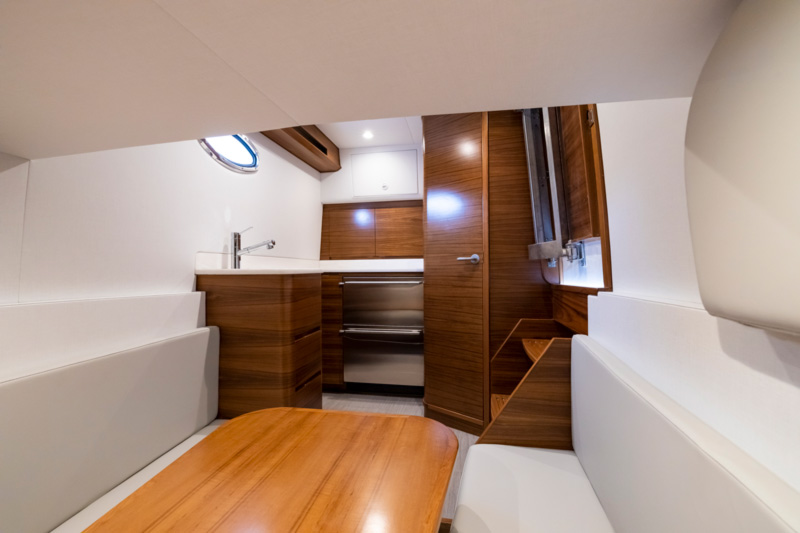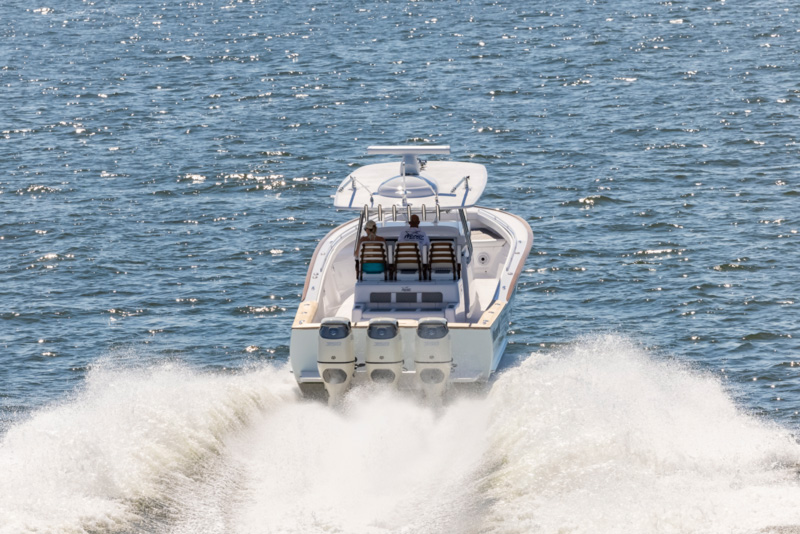Sea trialing a Weaver 41 Center Console is like unwrapping a mountain of birthday presents: you’re in for one pleasant surprise after the next. Set the throttles at 2500 rpm, and you’ll see the boat’s speed tick up into the upper teens as it comes onto plane a solid 500 to 1000 rpm earlier than most outboard-powered boats. Accelerate to a cruising speed of 40 to 42 mph and you’ll hear a fraction of the usual water noise. Nail the throttles and you’ll feel an utter absence of the common rapid-fire vibrations created by a hull blasting across the chop at speeds in the mid to upper 50s. Heck, even with the pistons in the triple Suzuki DF350A outboards firing off faster than an M134 gatling gun, it was so smooth at the helm that I could scratch legible notes on my reporter’s pad without a problem. That was a first. And, it served as just one more indication that this boat is different — very different — from any other 40-foot-ish center console on the water. So before we dig into the details, join us for a close inspection and a sea trial.
The Weaver’s hull is constructed of two layers of Okoume ply totaling over half an inch of thickness, encased in epoxy-impregnated E-glass and Kevlar. Stringers and battens are glass-encapsulated Douglass fir, decks are Okoume and Nidacore, and the finish is Awlgrip Awlcraft 2000 high-gloss urethane. Put those ingredients together and you bake a great-looking boat that’s stronger yet lighter than the competition, and more than that, it’s buoyant by nature. Drop a chunk of fiberglass in the water, and it sinks. Okoume floats. That translates into a better running boat and if you take a survey of the top multi-million-dollar custom-built sportfishing yachts in the world you’ll discover that the best of the best — legends like Bayliss, Jarret Bay, Mann, Rybovich, Spencer, and of course the larger Weaver sportfishing yachts as well — are all built with this cold-molded process.

The seakeeping and vibration-dampening effects of building with a naturally buoyant material like Okoume is very easy to sense for yourself, though it’s admittedly difficult to quantify. As the boat moves through the water and hits waves, it just feels like it wants to float. It doesn’t plow through nor bang so much as part and rise above the waves. And it doesn’t carve a turn so much as it sculpts one. It’s a sensation you have to feel for yourself to appreciate the full measure of the difference. But it’s also one that you’ll notice from the moment you take the wheel.
So, if this is the case why is it that the vast majority of modern boats are manufactured out of molded fiberglass? Because fiberglass hulls and decks can be laid up and popped out of a mold relatively quickly, and generally result in a pretty decent boat. But much as we may love our fiberglass-reinforced plastic fishing machines, truth be told, the laborious and time-consuming (read: more expensive) cold-molded construction method results in a superior watercraft. The proof is on the notepad.
Another advantage of building boats this way is the ability to customize every feature and facet. The 41 we tested was rigged to fish and fish hard, with a livewell in the transom, a pair of 65-gallon fishboxes in the deck, fresh and raw water washdowns, triple 16-inch Garmin MFDs rigged on a NMEA2000 backbone, spreader lights integrated into the hard top, six rocket launchers, 22-foot carbon-fiber Rupp outriggers, six flush-mount gunwale rodholders, and an aft bait-watching seat with a tackle station plus an integrated 65-quart Yeti underneath. But if you want two livewells in the corners or a different layout in the leaning post, making those custom changes is no problem.

When designing the 41 Weaver also gave a nod to creature comforts, incorporating a climate-controlled cabin in the console with a galley (including a microwave, refrigerator/freezer, sink, and Corian countertops), a dinette that converts into a V-berth forward, plus a fully enclosed stand-up head. The center of relaxation will, however, be the forward console chaise lounge. It has room for two people to stretch all the way out and kick back between casts or cocktails. Plus, there’s additional seating forward in the bow.
Speaking of design: we should note that the 24-degree deep-V bottom, which begins with Carolina flare at the bow and ends with tumblehome at the transom, is the brainchild of Donald L. Blount and Associates. You know, the naval architecture firm responsible for two out of the world’s three fastest yachts, the U.S. Navy’s Mako patrol boat, and designs used by the likes of Buddy Davis, John Bayliss, and Jim Smith? Yeah, that Donald L. Blount and Associates.
Along with hull design, the boat’s weight again comes into play when considering performance. The 41 weighs about 17,000 pounds, while similarly sized competitors built with vacuum-infusion, the most technologically advanced way to minimize weight and maximize strength in a molded fiberglass boat, tip the scales at more like 20,000 pounds. That’s a 15-percent weight savings, and it helps explain why many competing boats of this size and type require several hundred additional horsepower and/or quads.
In the interest of fairness, this is normally where we’d note that there’s a trade-off with shaving weight from a boat in that it gets tossed around more easily by the seas and doesn’t bull waves out of the way the same as a heavier boat might. At the risk of sounding biased, we will instead note that the “usual” simply doesn’t apply in this case thanks to that cold-molded construction factor. Again, you have to feel this phenomenon for yourself to believe it and we don’t expect anyone to take these written words as Gospel. Go for a sea trial, and then judge for yourself.

Still, biased or not we all know there’s no such thing as a perfect boat and everything involved in designing and building a boat requires trade-offs. So, where are the downsides in this case? Remember, cold-molding is more laborious and time-consuming than popping fiberglass out of a mold. And as a result, it also costs more. While similar-sized competitors generally go for $700,000 to $800,000 or so fully rigged, this boat costs more like $950,000. Consider, however, that the difference seems a bit less substantial when you remember that Weaver includes big-ticket items (like a Seakeeper 5 gyro-stabilization system, Optimus steering with joystick control, and a six-kW Fisher Panda diesel genset) in the complete package.
Another cost-mitigating factor is resale value. While no one can predict where the boat market will go in the future, cold-molds and similar custom boats commonly hold their value much better than the average molded glass boat. Remember: this is a unique center console which many people will consider art as much as fishing machine. It’s likely to be valued accordingly.
You want the ultimate 41-foot center console, customized to meet your exact wants and needs? Take a 41 Center Console for a sea trial, and enjoy the pleasant surprises one after the next. And after feeling the difference of having a cold-molded Weaver underfoot for yourself, we promise not to say we told you so.
Weaver 41 CC Specifications:
LOA – 43’0”
Beam – 11’6”
Displacement – 17,000 lbs.
Fuel Capacity – 400 gal.
Water Capacity – 52 gal.
Transom Deadrise – 24 degrees
Max. Power – NA
Area Dealers – Weaver Boatworks, (410) 867-8757
BONUS Feature: Weaving the Dream
Jim Weaver first dabbled in boatbuilding as a teenager and has been building cold-molded sportfishing boats in Tracys Landing, MD, for decades. After building high-dollar convertibles which travelled sportfishing circuits across the Americas, he added 43- and 50-foot Chesapeake Bay-style fishing boats to his repertoire. “I was tired of seeing all the boats we built leave and go to places like Florida or Costa Rica,” he explains. “We never got to see them again.”
Why then branch out into the world of center consoles, a move that few builders utilizing cold-molded construction have made?
“I wanted to build this boat because it seems like everyone wants a center console today and I thought I could build one that was a little unique, a little different from what everyone else is building,” he says. “The ride tells the story. Cold-molded boats have a different ride and different characteristics than a fiberglass boat. They run better, and they’re quieter.”
As we’ve stated, the superior ride has to be experienced first-hand to fully comprehend and can’t be easily quantified. However, when it comes to how much quieter a cold-molded boat can be (thanks to the vibration-absorbing nature of its wood core), holding a dB-A meter at the helm of the 41 provides empirical evidence. At a 4500-rpm cruising speed we measured 86 dB-A and at wide-open throttle, 91. Molded glass boats of this size and type typically push 90 dB-A at cruise and often peak at 95 to 97. Note that the dB-A scale is logarithmic so a jump of five is significant — about the same as the difference between a ringing phone and a running blender.